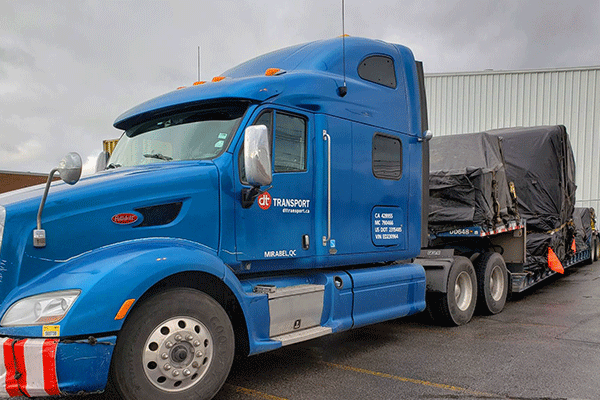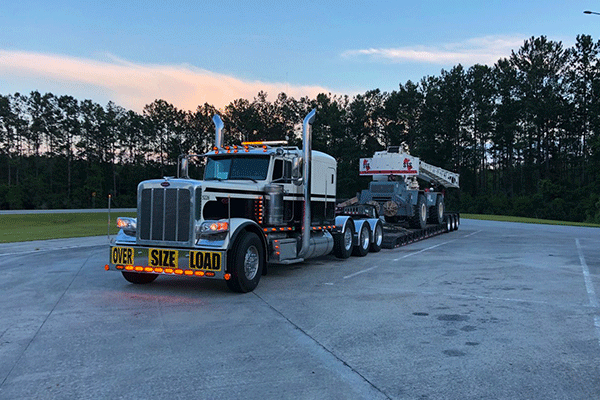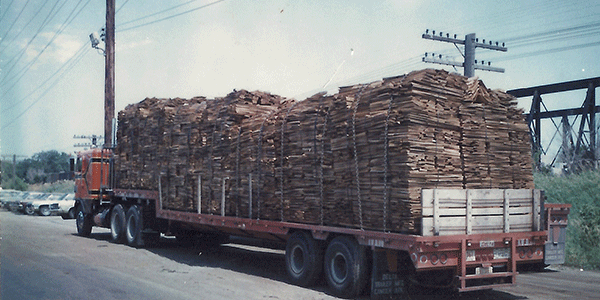As a shipper, you know that having a good grasp on what it should cost to move your freight is important, but it feels like it's getting harder to do so these days. This makes you wonder what causes shipping rates to change today when compared to years past.
Here at ATS logistics, we understand that this industry is dynamic. We’ve been around long enough to know that as time goes on, prices fluctuate.
In this article, we’ll discuss how shipping rates have and will continue to change in this complex industry by breaking down:
- How supply and demand have impacted shipping rates.
- How fluctuations in fuel prices impact shipping rates.
- What these changes mean for shippers.
- What these changes mean for carriers.
- How you can avoid paying more.
How Supply and Demand Have Impacted Shipping Rates Over Time
The price of hauling a load from one point to another has always been dictated by supply and demand. In this industry, supply is the amount of equipment available to move a shipment and demand is the amount of freight needing to be moved. The balance between supply and demand undergoes ebbs and flows with time.
We can pinpoint four separate factors that work in tandem to influence supply and demand and push shipping prices up. These factors are:
- The number of truck drivers available
- The advent of the internet
- The adoption of new technologies
- Unpredictable disruptors

The Number of Truck Drivers Available
For over a century, this industry has served as the backbone of the U.S. economy, supporting all industries. Today, over 70 percent of the freight moved across the U.S. each year is done via semi-truck. Although there are alternative options for moving a shipment, using a truck is easily the most common mode of transport.
30 years ago — before the onset of the digital age — truck driver training programs were brimming with young adults, eager to make their mark on America’s supply chain. Back in those days, the number of truck drivers available was easily sufficient to keep pace with the demand for their services. As such, the price to haul each load was consistent and predictable. Demands were met and extra capacity was readily available.
As time wears on, a lot of things evolve and the anatomy of the trucking industry — although fundamentally unchanged — has seen a shift.
The truck driver training programs that were full in decades past are now resting well below capacity. Kids graduating from high school don’t appear to be as interested in becoming truck drivers as they had previously.
The desire to travel the country untethered from the constructs that sitting behind a desk brings has seemingly vanished from the latest generation. A generation that the trucking industry truly needs.
This drop-off in the recruitment of new truck drivers is a prime factor influencing the price fluctuations seen in the shipping market today.
Since there are fewer trucks available, the price you pay for a truck increases.
To further address this question, we’ve put together an in-depth look at how the truck driver shortage is impacting freight costs.
The Shiny New Internet
Since the advent of the internet, the simple act of clicking a button has led to the commoditization of this industry.
In the grand scheme of the shipping industry, the internet is a relatively new variable. Although it is often a great tool, for the trucking industry, the internet is a double-edged sword. Where consumers gain the ability to order their groceries online, the trucking industry experiences a firm tug, testing its ability to meet the rising demand.
Herein lies the downside of the digital age’s interaction with the trucking industry. It’s just hard to keep up.
As people sit at home, shopping behind their mobile devices and waiting for their packages to arrive, a truck driver is working. It’s not magic. Every item ordered on the internet today is directly tied to the truck it will be transported in. As consumerism surges on an endless uphill climb, to maintain shipping prices the number of trucks available must do the same.
Recently, there just hasn’t been a large enough supply of transportation solutions available to service the shippers that need to get their product moved. A product whose production is dictated by the people using the internet.

Technological Advances in the Trucking Industry
In addition to the stress the internet has put on this industry’s supply chain, other technological advances have made an impact on its capabilities.
Most notably, the advances that have led to increased access to the information vital to this industry, have made their impact on supply and demand.
These technologies include but are not limited to:
- Automated freight matching
- Software systems (market tracking, route planning and industry trend analysis)
- Freight tracking systems
Here is a quick example of how technology is making an impact on the trucking industry:
In the decades predating the internet, truck drivers would have to search for a load using the scrolling load boards posted at truck stops. Drivers would then contact the shipper or broker who posted the load using their contact information (fax and phone numbers). This process was not nearly as quick and easy as it is today, and drivers had far less visibility to price fluctuations in the market.
Today, the technological advances in the process of booking a load has made a large impact on the ability of carriers to compete. In a market whose variables are made easily visible at the touch of a button, a carrier can choose a load based on location, price, length of haul and convenience.
This added ability for carriers to weigh options and analyze trends adds volatility to the trucking marketplace.
Unpredictable Disruptions
In January 2020, the first case of Coronavirus was discovered in the U.S.
Since that time, this nation has been shaken to its core by a virus that just won’t quit. In addition to the grave toll the pandemic has taken on our society, its influence has been seen in the shipping industry.
In a year where the large majority of America’s businesses had to shut down for a time, so too did driver training schools. This shutdown influenced — in large part — the freight transportation industry’s ability to do its job.
This combination of closed driver schools and an increase in demand, coupled with a spike in our country’s unemployment level, transformed what was already a hyperextended supply chain into a perfectly crafted recipe for disaster.
Maybe, as the pandemic subsides and people go back to work, there will be a stabilization as we get back to business as usual. Maybe, our world will never be the same and we won’t ever go back to the ways of the past. Either way, it is safe to say the Coronavirus has opened our eyes to a weakness in the foundation of the shipping industry. Unbridled demand is rising, supply is not.
Disruptors like the pandemic occur at unpredictable intervals over time. Two prime examples of these are: significant weather events (hurricanes, blizzards, earthquakes, etc.) and historical events (war, acts of terror, riots, etc.).
When these events occur, the balance between supply and demand is disrupted impacting the price you pay.
How Fluctuations in Fuel Prices Impact Shipping Rates
Another big factor in how shipping rates have changed over time is the price of fuel.
In 1980, the price for one barrel of crude oil was $37.42. In 2019, that same barrel of oil was priced at $50.46. As fuel prices increase, the price you pay to move your freight must increase to match.
Fuel prices are billed as a direct cost to the driver, and the more fuel costs — the more a shipper pays.
These fuel surcharges have been around since the early 1980s when the Motor Carrier Act took significant steps to deregulate the market. This deregulation created the perfect environment for the transportation industry to expand. As such, following deregulation, the number of trucking companies in this industry quickly doubled.

A fuel surcharge is a way to take your total rate and remove fuel from the equation to benchmark the carrier’s cost-per-mile (CPM). Carriers use the Department of Energy’s average fuel costs to level the charge.
Note, crude oil prices are subject to large fluctuations year over year as supply and demand in that industry experience changes. Once again, it all comes back to supply and demand.
What Do Price Changes Mean for Shippers?
Over time, shippers have had to adjust the amount they are willing to pay to meet what supply and demand dictate. If they can get someone to move it for cheaper, good. If not, they are subject to the going market price.
There’s no getting around it. If a shipper wants to get their freight to their receiver, they need to pay whatever it costs to do so.
For the most part, this hasn’t been an issue as the number of trucks available firmly meets the demand for their services. Shippers haven’t had to plan ahead to the extent that they do today. 30 years ago, shippers didn’t need to worry about whether there would be a truck available when their products left the production line.
As you already know, this hasn’t been the case for at least a few years. Now, shippers must plan ahead to ensure their freight will have a reasonably priced transportation solution available to it.
What Do Price Changes Mean for Carriers?
The amount of price leverage in the hands of carriers is directly tied to the balance of supply and demand. As such, carriers are constantly needing to adjust to current market conditions.
A prime example of this occurred at the beginning of 2020 with the first wave of Coronavirus.
During this time, the supply of trucks severely outweighed the demand for the movement of freight. As a result, carriers were left scrambling to take any load that the shipper could muster. This added competition led to a sharp decrease in the amount of money a carrier was paid to haul any given shipment.
As you may suspect, over time these things change and a carrier must be agile. The market that was so void of demand one year ago, is now booming. This leaves carriers with a tough road ahead. Without the next generation of truck drivers — drivers that could be relied on in decades past — stepping into the roles readily awaiting them, meeting demand will become more difficult.
How Can You Avoid Paying More?
In an industry dictated by supply and demand, the amount of time you give your transportation provider to make arrangements for your freight is important when it comes to securing the best price.
Another great way to make sure you’re getting the best value for your transportation dollars is to educate yourself. Make sure you do all the necessary research when selecting a transportation provider.
- Can they meet the capacity you need?
- What are their specialties?
- Do they have a good track record?
- What is the history of their business?
Choosing the correct provider to partner with can go a long way toward ensuring you get the very best price for current market conditions.
Don’t always look for the cheapest price when choosing a provider. Search for the best fit for your needs. Look for a partner who openly communicates with you from the beginning and fosters a relationship of transparency with their clients.
They shouldn’t be looking to make a million dollars on one deal, but rather to make one dollar on a million deals. That is the foundation of good business.
How You Can Better Forecast Shipping Rates
This blog has left you with a better understanding of how and why shipping costs have changed over time, and how these changes translate to the prices you see today. Be it, a fluctuation in supply based on the number of drivers available or a change in demand as new technologies continue to shape the transportation ecosystem, the price you pay to ship your freight will continue to evolve.
If you need help finding the transportation service provider that is best for your business — or simply want some clarification on a question that you have — reach out to us. Helping shippers like you is what we’re here for.




